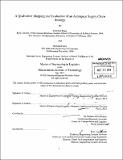| dc.contributor.advisor | Roberto Perez-Franco. | en_US |
| dc.contributor.author | Hung, Jonathan (Jonathan W.) | en_US |
| dc.contributor.author | Pierce, Nicholas | en_US |
| dc.contributor.other | Massachusetts Institute of Technology. Engineering Systems Division. | en_US |
| dc.date.accessioned | 2012-01-30T16:52:18Z | |
| dc.date.available | 2012-01-30T16:52:18Z | |
| dc.date.copyright | 2011 | en_US |
| dc.date.issued | 2011 | en_US |
| dc.identifier.uri | http://hdl.handle.net/1721.1/68823 | |
| dc.description | Thesis (M. Eng. in Logistics)--Massachusetts Institute of Technology, Engineering Systems Division, 2011. | en_US |
| dc.description | Cataloged from PDF version of thesis. | en_US |
| dc.description | Includes bibliographical references (p. 55-56). | en_US |
| dc.description.abstract | An effective supply chain is critical to the success of the products and services sold by companies. Companies must have an explicit understanding of what the supply chain strategy is in order to evaluate it. While most organizations have well-documented business strategies, they lack the same for their supply chain strategy. The methodology proposed by Perez-Franco, Singh, and Sheffi (201 1a; 201 1b) is a way to evaluate a supply chain strategy by using interviews, surveys, and discussions. The goal for this project was to test the applicability of the Perez-Franco et al. methodology to the aerospace industry through an applied case. We conducted a qualitative mapping of the supply chain strategy for a specific satellite program in Lockheed Martin Space Systems (LMSS). This thesis research is the first time the methodology has been applied and tested with a company in the aerospace industry. As a whole, LMSS has increased focus on their supply chain, and works to directly align their supply chain with their business objectives. For our case, we selected a specific project within the Space Systems division that lacks an explicitly stated supply chain strategy and has a potential gap with objectives. Through our research, we found that the Perez-Franco et al. methodology is applicable to the aerospace industry. As a result of this case application, we propose and present potential deviations and additions to build upon the methodology that yields interesting insights. The results with LMSS revealed areas of disagreement identified through evaluating themes of support, consistency, and sufficiency. Additionally, the methodology allowed us to conduct a diagnostic of the supply chain strategy against business goals. The primary conclusion in the diagnostic was a perceived conflict between quality and affordability initiatives. This is the key recommendation that the company should investigate further to locate the root cause(s) of the disagreement. Outcomes from this case show that the methodology can be applied to a wide number of industries. | en_US |
| dc.description.statementofresponsibility | by Jonathan Hung and Nicholas Pierce. | en_US |
| dc.format.extent | 56 p. | en_US |
| dc.language.iso | eng | en_US |
| dc.publisher | Massachusetts Institute of Technology | en_US |
| dc.rights | M.I.T. theses are protected by
copyright. They may be viewed from this source for any purpose, but
reproduction or distribution in any format is prohibited without written
permission. See provided URL for inquiries about permission. | en_US |
| dc.rights.uri | http://dspace.mit.edu/handle/1721.1/7582 | en_US |
| dc.subject | Engineering Systems Division. | en_US |
| dc.title | A qualitative mapping and evaluation of an aerospace supply chain strategy | en_US |
| dc.type | Thesis | en_US |
| dc.description.degree | M.Eng.in Logistics | en_US |
| dc.contributor.department | Massachusetts Institute of Technology. Engineering Systems Division | |
| dc.identifier.oclc | 772173871 | en_US |
